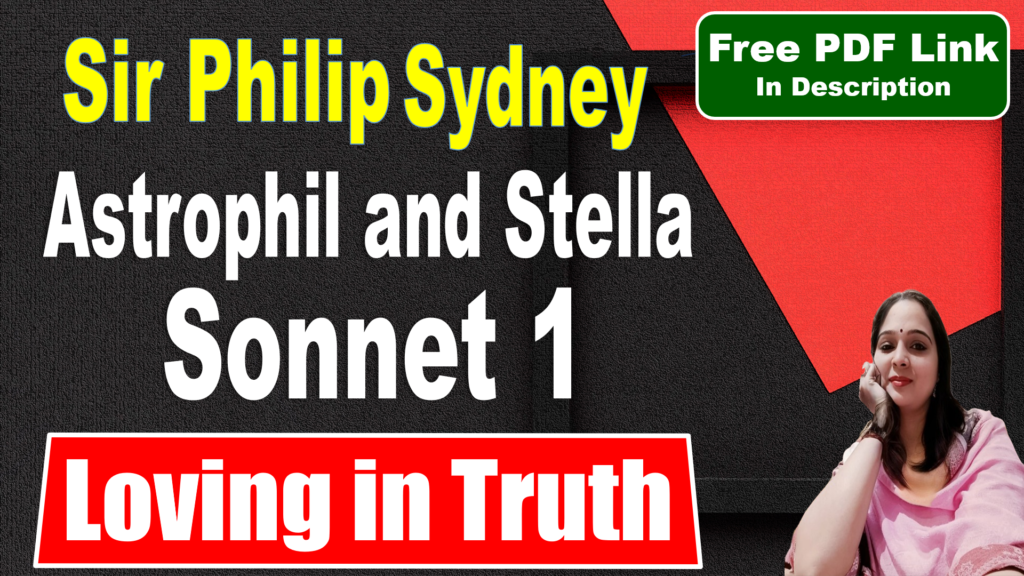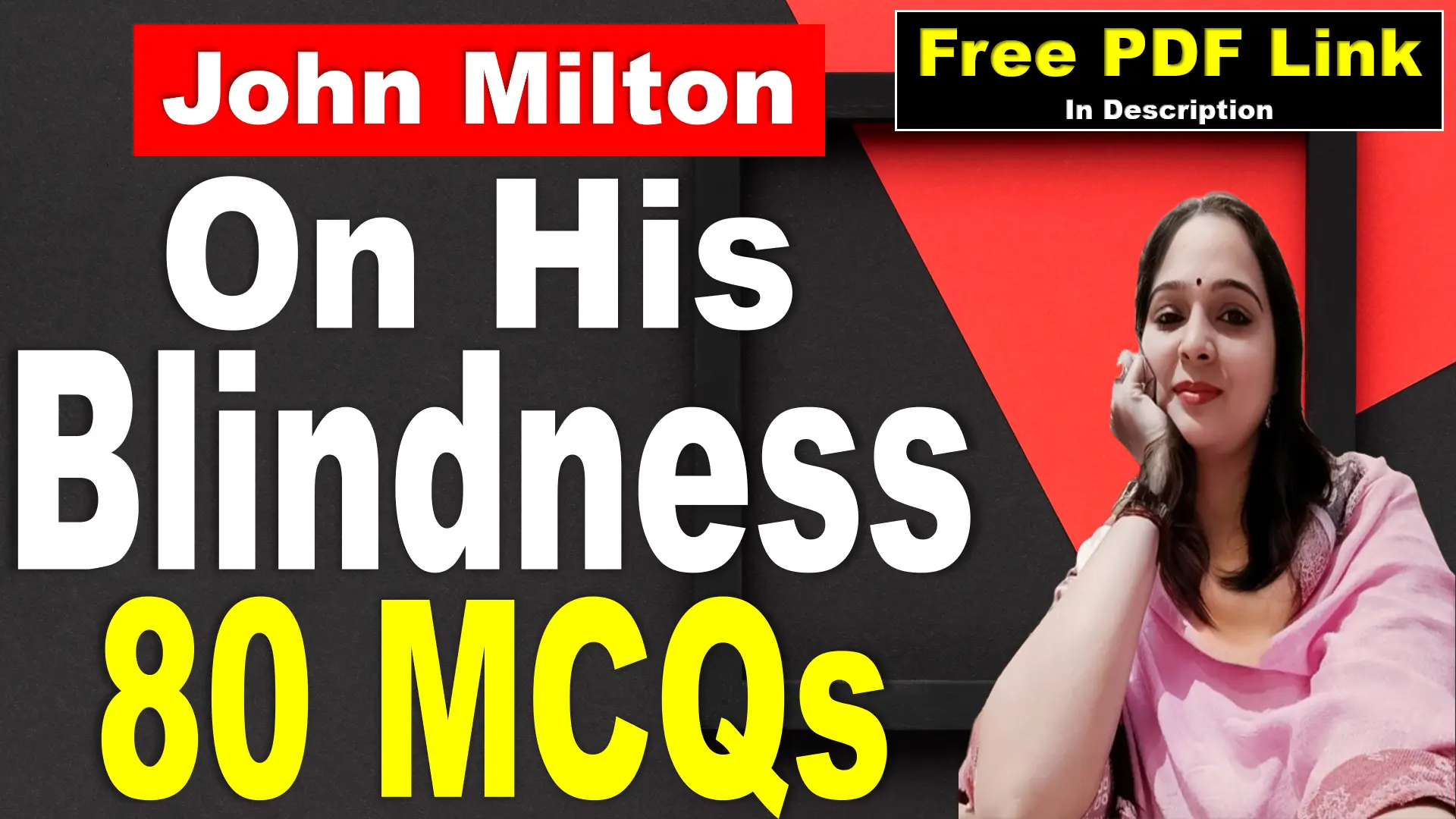
Astrophil and Stella Sonnet 1 Questions and Answers
Very Short Answer Questions
Who is the author of Sonnet 1?
Sir Philip Sidney.
What is the title of the sonnet sequence to which Sonnet 1 belongs?
Astrophil and Stella.
Who is the speaker in the poem?
Astrophil.
Who is Astrophil’s love interest in the poem?
Stella.
What does Astrophil hope to achieve through his poetry?
To win Stella’s love.
What literary device is used in “blackest face of woe”?
Metaphor.
What advice does the Muse give to Astrophil in the final couplet?
“Look in thy heart and write.”
What does “step-dame Study” represent in the poem?
The stifling effects of over-studying and imitation.
What type of sonnet is Sonnet 1?
English sonnet.
What is the rhyme scheme of Sonnet 1?
ABAB ABAB CDCD EE.
What is Astrophil’s primary emotional struggle in the poem?
His inability to find the right words to express his love.
Which poetic device is used in “biting my truant pen”?
Personification.
What does Astrophil hope Stella will feel after reading his poetry?
Pity for his suffering.
What frustrates Astrophil when writing his poetry?
His words come out halting and lack creativity.
What is the “sunburned brain” a metaphor for?
Astrophil’s exhausted and blocked mind.
What does Astrophil do to try to stimulate his creativity?
He reads other poets’ works (“others’ leaves”).
What is the tone of the poem?
Frustration and self-reproach.
What does Astrophil hope “pity” will lead to?
Grace (Stella’s love).
What is the poetic form of the final two lines of the sonnet?
A rhymed couplet.
What key message does the poem convey about poetry?
True poetry comes from the heart, not from study or imitation.
Short Answer Questions
What is Astrophil’s primary goal in writing poetry, as expressed in Sonnet 1?
Astrophil’s main goal in writing poetry is to express his deep love for Stella in hopes that she will take pleasure in his verses. He imagines that her enjoyment of his poetry might lead her to understand his suffering, feel pity for him, and ultimately return his love. Astrophil sees poetry as a way to communicate his emotions and win Stella’s affection.
How does Astrophil describe his struggle with writing in Sonnet 1?
Astrophil expresses great frustration with his inability to find the right words to express his feelings. He tries to study and borrow ideas from other poets (“turning others’ leaves”), but despite his efforts, his words come out “halting” and awkward. He feels creatively blocked, unable to channel his emotions effectively into his poetry.
What role does the Muse play in the sonnet?
In the final couplet, Astrophil’s Muse intervenes and offers crucial advice. She calls him a “fool” for relying on studied techniques and external sources, and instead urges him to “look in thy heart and write.” The Muse emphasizes the importance of authenticity in poetry, suggesting that true inspiration comes from personal emotions rather than forced creativity or imitation.
What is the significance of the metaphor “blackest face of woe” in the poem?
The phrase “blackest face of woe” is a metaphor for Astrophil’s intense sorrow and emotional suffering. He wants to capture and express the darkest aspects of his pain in his poetry. This metaphor emphasizes the depth of his despair over his unrequited love for Stella and reflects his desire to convey it vividly in his writing.
How does Astrophil view the works of other poets in his creative process?
Astrophil looks to the works of other poets (“others’ leaves”) in hopes of finding inspiration for his own writing. He turns to them with the expectation that their creativity might help stimulate his own. However, he ultimately finds that the works of others seem foreign and unhelpful, as they don’t align with his personal voice or emotional needs, leaving him frustrated.
What does the line “Invention, Nature’s child, fled step-dame Study’s blows” mean?
This line personifies “Invention” (creativity) as the natural child of inspiration, which has fled due to the harsh blows of “Study” (over-reliance on learned techniques). Astrophil is saying that his natural creativity has been stifled by his excessive focus on scholarly approaches and imitation, which has caused his inspiration to abandon him.
How does Sidney use the sonnet form to structure the speaker’s emotional journey?
Sidney uses the traditional sonnet form, with three quatrains and a final couplet, to guide Astrophil’s emotional journey. In the quatrains, Astrophil expresses his frustration and struggles with writing poetry, while in the final couplet, the Muse provides a resolution by advising him to write from the heart. This structure mirrors the progression from confusion to clarity.
What is the theme of authenticity vs. artifice in Sonnet 1?
The poem explores the theme of authenticity vs. artifice by contrasting Astrophil’s attempts to force creativity through study and imitation with the Muse’s advice to write from genuine emotion. The Muse suggests that poetry should come from the heart, implying that authentic feelings are more valuable than artificially constructed ideas or borrowed inspiration.
Why does Astrophil bite his pen and beat himself for spite?
Astrophil bites his pen and beats himself out of frustration and self-reproach. His inability to express his feelings properly causes him to direct anger toward himself. The “truant pen” symbolizes his failed attempts at writing, and he blames himself for his creative block and the ineffectiveness of his poetic efforts.
What is the tone of the final couplet, and how does it contrast with the earlier tone of the poem?
The tone of the final couplet is more direct and corrective, as the Muse offers Astrophil clear advice to “look in thy heart and write.” This contrasts with the earlier tone of frustration and confusion, where Astrophil feels creatively blocked and unsure of how to proceed. The couplet provides a resolution and shifts the tone to one of clarity and encouragement.






Mam amake” ode of girls ‘ things” by Sharon olds koran please 🥺 mam please 🥺❤️ poetry